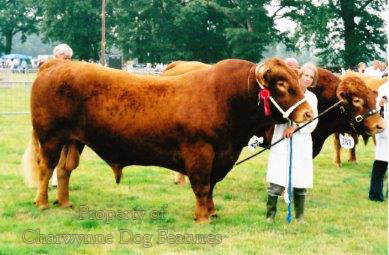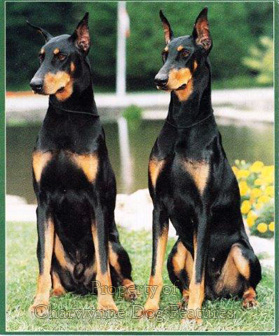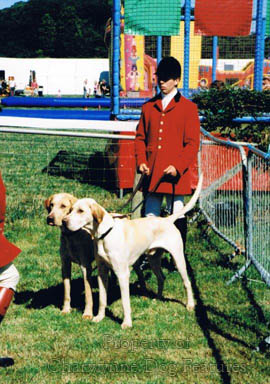225 Show Condition
WHAT IS 'SHOW CONDITION'?
by David Hancock

 Spending a day at the National Working Breeds Dog Society's 24th Group Championship Show at Malvern in mid-July left me quite shocked. Not by the disgusting lavatories, the poor catering and the abysmal lack of signs for the public car park but by the physical condition of far too many of the exhibits. Is this not the show of the year for those breeds that have to work? I use the word 'shocked' quite legitimately because, if the breeders, the exhibitors and especially the judges are prepared to go along with this situation, there is something fundamentally wrong -- with worrying possibilities for the future.
Spending a day at the National Working Breeds Dog Society's 24th Group Championship Show at Malvern in mid-July left me quite shocked. Not by the disgusting lavatories, the poor catering and the abysmal lack of signs for the public car park but by the physical condition of far too many of the exhibits. Is this not the show of the year for those breeds that have to work? I use the word 'shocked' quite legitimately because, if the breeders, the exhibitors and especially the judges are prepared to go along with this situation, there is something fundamentally wrong -- with worrying possibilities for the future.
Of those who argue that such a show is just a beauty contest and the condition of the dogs an afterthought, let me ask a couple of questions. Firstly, when did you ever see a national beauty queen with a spare tyre and podgy limbs? Secondly, what is the point of having a serious hobby if you don't take it seriously, especially if you want to win? And thirdly if exhibits are expected to be in "show condition", why are judges taking a different view? I was also disturbed to watch four successive classes of one breed being 'judged', without the exhibits' feet once being examined. The bite of each dog was checked and infinite care taken over the comparative assessment of the entry. But feet are crucial to working breeds, more important even than mouths. Why does the organisation inviting the judge invite such an inadequate individual?
But what is actually meant by the expression 'show condition'? The Kennel Club's Glossary of Terms defines condition as: "Health as shown by the body, coat, general appearance and deportment. Denoting overall fitness." Not brilliantly written but the last phrase is the key one. Frank Jackson, in his most useful "Dictionary of Canine Terms", defines condition as: "Quality of health evident in coat, muscle, vitality and general demeanour." Harold Spira, in his "Canine Terminology", describes it as: "An animal's state of fitness or health as reflected by external appearance and behaviour. For example, muscular development..." The Breed Standards and Stud Book Sub-Committee at the KC inform me that show condition indicated an expectation of "a dog in good health as indicated by good coat condition, good muscle tone, a bright eye and up on the feet", adding that any competent judge would know this. One thing is inescapable in the interpretation of these definitions, condition means fitness as demonstrated in the dog's muscular state.
Why then, at the working breeds show of the year, were judges putting up dogs in poor muscular condition and quite clearly not fit? Is it ignorance, incompetence or indifference? Some of the judges I watched simply did not know soft muscle from hard and seemed incapable of detecting the absence of muscular development. I shudder to think where this will lead us! Judging livestock is essentially a subjective skill based on what you see in the entry NOT what the exhibitor wants you to see. Rather than a reaction to the animal before you, it is more a conscious action to relate the animal presented to you in the ring to the beau-ideal for that particular breed.
If we are going to accept unfit exhibits lacking muscular development as challenge certificate material, then novice exhibitors are being given a wholly undesirable impression and standards have already become unacceptably low. We are in effect betraying the work of the skilful pioneer breeders who handed these fine breeds down to us. That apart, where is the pride of the breeders, owners and handlers concerned? Who admires a puny, unfit, under-developed dog or an obese flabby one ? These breeds were designed to work! What sort of encouragement is this to those admirable exhibitors who spent hours getting their dogs into real show condition?
In his book "All About the Bullterrier", the much-missed Tom Horner recorded: "A wise breeder puts on show only his best stock and presents them in the peak of condition, physically fit, clean and trained to show off their points". Are we losing our way as we lose our most experienced, most knowledgeable, most informed judges? There were not many dogs at Malvern in mid-July 1995 in the peak of condition. There were far too many demonstrably not physically fit. Some of these were actually favoured by the judges. If this is the case at a show of this standing, where will it all end -- with prizes for fat dog of the day?
In his informative "The Practical Guide to Showing Dogs" of 1956, Captain Portman-Graham wrote: "The fact that a dog is structurally sound is not in itself sufficient to ensure that it will always win at shows. It is of paramount importance that it must be...at the highest standard of condition..Perhaps one of the biggest advantages which dog showing confers on the dog as an animal is the care which must be bestowed upon it." If unfit dogs with poor muscular condition can win at dog shows, then the whole argument that such shows improve dogs is totally destroyed. Dogs which are inadequately exercised and merely wheeled out for the next show can be so easily identified by any competent judge and quickly thrown out of the ring that such an insidious practice, both for dogs and the dog game, can be ended. Are our current crop of judges up to this?
The esteemed Portman-Graham went on to write: "...exercise is a vital consideration in maintaining any breed of show dog in bloom, health and vigour...When one watches the beautiful muscles of a racehorse one sees a similarity between a dog's muscles which have been developed correctly and naturally, and ripple in movement. Yet there is evidence of lack of muscular tone and development in many show breeds today." He would not have liked the rings at the 1995 Working Breeds Show. Surely such a show should be didactic not merely epideictic; in other words it has a role in teaching those wanting to learn not just being conducted literally for show. A dog show, properly conducted, should attract exhibitors not exhibitionists.
But what are the reports from other shows producing on this theme? Here are extracts from some: Dobermann bitches -- "I do worry however about the number that are presented in overweight, flabby condition and also those that are the right weight and shape but are soft and without muscle." Bearded Collie dogs -- "So many dogs were lacking in muscle tone -- does no one exercise their dogs anymore?" Labrador Retrievers -- "Yes, I am saying that many were very overweight!" Rottweiler bitches -- "A Rottweiler is classed as a herding breed, they are supposed to herd cattle not look like them..." Rough Collie bitches (at Crufts) -- "But I was faced with many, very fat, cloddy shaped bitches, who because of the fatness...moved so badly". Hungarian Vizslas -- "Some dogs lacked bone and robust bodies, many lacked muscle tone..." Mastiffs -- "What I would criticise is the fact that too many were overweight and lacked muscular tone. Nothing is achieved by piling on surplus flesh..."
I would go further than the last judge and state that surplus flesh can only do harm. Nowadays we are bombarded with verbal and written instructions from a host of nutritionists and crafty manufacturers at shows yet I see more fat dogs these days than ever before. We all know that an overweight dog is an unhealthy dog. If exhibitors produce unhealthy dogs in the ring then every judge has a duty to point this out and decline entry to such exhibits. If a judge does not take this course of action, then a complaint should be made to the KC. This wholly undesirable situation in which unfit unhealthy dogs are allowed in show rings simply cannot be condoned.
Those who exhibit dogs in a show ring have a distinct role in demonstrating to the public what the pedigree breeds should look like when presented, in show condition, to the judge. Their dogs should be exemplars of cosmetic excellence. The public as spectators, and novices as students, should not only admire what they see in the ring but be guided by the standards there. If an exhibit needs a good bath, it should, in rugby league parlance, be sent for an 'early bath'. If its claws need cutting, its teeth need cleaning, its coat needs unmatting and its eyes and ears need a thorough wipe, then the exhibit is not ready for its class and should be banished until it is. Soft-muscled and overweight dogs however pose a much more important, more long term problem.
Writing in the Summer 1995 number of "You and Your Vet", Simon Wolfensohn, a vet worth heeding, recorded that three out of every ten pet animals are overweight and that more pets are killed by misplaced kindness than are starved. He identified the concomitant health problems: fatty deposits around the heart, fat damage to the liver, weakness of muscles caused by fat deposits, diabetes and even arthritis because of the increased burden on the joints. He cited the cases of a Bouvier des Flandres which weighed 132lbs (the weight of two Bouviers on one set of legs) and of a German pointer of 95lbs, roughly twice her desired weight.
If you purchase an expensive pedigree dog, why try to feed it to death? If you spend time and money breeding and exhibiting pedigree dogs, why frustrate yourself by putting dogs in the ring which cannot win? I should hastily add "should not win", for the judge makes this differentiation. Sixty or so years ago, Theo Marples, writing in his "Prize Dogs", put the condition of a dog in the ring ahead of its ability to 'show'. He also wrote that "It is always best not to show a dog in bad condition, even although he may be entered for a show. Many a good dog has met defeat and tarnished his reputation by being exhibited in indifferent condition". I see dogs "in indifferent condition" being presented to the judge at most of the shows I go to. What folly! Some of the owners of such dogs moan later about the standard of the judging when their dogs fail to gain a place. Winning is all about the pursuit of excellence, not just turning up on the day.
Are soft-muscled overweight exhibits now actually becoming acceptable at shows? If so, then we have not only too many incompetent judges but a potential disaster on our hands. For, if, as is claimed, the improvement of dogs is the Kennel Club's mandate and dog shows are the vehicle for this, then permitting soft-muscled overweight dogs even to enter the ring substantially undermines this claim. Pedigree dog shows, and Working Breed shows in particular, must demonstrate to the dog-owning public what each breed should look like in peak condition. If this is not happening, then the whole credibility of pedigree dog breeding is put at risk. There is now an urgent need for us to exercise our minds as well as our dogs.